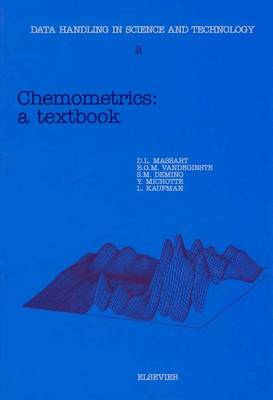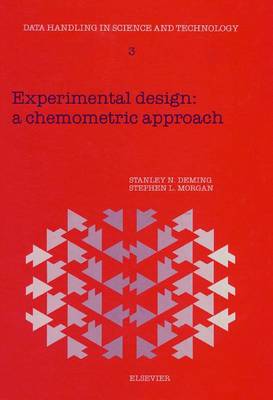Data Handling in Science and Technology
1 primary work • 6 total works
Book 11
Chemometrics
by Deming, S N Deming, Y Michotte, D L Massart, L. Kaufman, and B G M Vandeginste
Published 1 February 1988
Most chemists, whether they are biochemists, organic, analytical, pharmaceutical or clinical chemists and many pharmacists and biologists need to perform chemical analysis. Consequently, they are not only confronted with carrying out the actual analysis, but also with problems such as method selection, experimental design, optimization, calibration, data acquisition and handling, and statistics in order to obtain maximum relevant chemical information. In other words: they are confronted with chemometrics. This book on chemometrics, written by some of the leaders in the field, aims to provide a thorough, up-to-date introduction to this subject. The reader is given the opportunity to acquaint himself with the tools used in this discipline and the way in which they are applied. Some practical examples are given and the reader is shown how to select the appropriate tools in a given situation.
As such the book provides the means to approach and solve analytical problems strategically and systematically, without the need for the reader to become a fully-fledged chemometrician. The authors' aim was to write a tutorial book which would be useful to readers at every level in this field.
As such the book provides the means to approach and solve analytical problems strategically and systematically, without the need for the reader to become a fully-fledged chemometrician. The authors' aim was to write a tutorial book which would be useful to readers at every level in this field.
Experimental Design: A Chemometric Approach
by Stanley N Deming, Stephen L. Morgan, S N Deming, and S L Morgan
Published 1 January 1987
Now available is the second edition of a book which has been described as "...an exceptionally lucid, easy-to-read presentation... would be an excellent addition to the collection of every analytical chemist. I recommend it with great enthusiasm." (Analytical Chemistry)
N.R. Draper reviewed the first edition in Publication of the International Statistical Institute "...discussion is careful, sensible, amicable, and modern and can be recommended for the intended readership."
The scope of the first edition has been revised, enlarged and expanded. Approximately 30% of the text is new. The book first introduces the reader to the fundamentals of experimental design. Systems theory, response surface concepts, and basic statistics serve as a basis for the further development of matrix least squares and hypothesis testing. The effects of different experimental designs and different models on the variance-covariance matrix and on the analysis of variance (ANOVA) are extensively discussed. Applications and advanced topics (such as confidence bands, rotatability, and confounding) complete the text. Numerous worked examples are presented.
The clear and practical approach adopted by the authors makes the book applicable to a wide audience. It will appeal particularly to those with a practical need (scientists, engineers, managers, research workers) who have completed their formal education but who still need to know efficient ways of carrying out experiments. It will also be an ideal text for advanced undergraduate and graduate students following courses in chemometrics, data acquisition and treatment, and design of experiments.
N.R. Draper reviewed the first edition in Publication of the International Statistical Institute "...discussion is careful, sensible, amicable, and modern and can be recommended for the intended readership."
The scope of the first edition has been revised, enlarged and expanded. Approximately 30% of the text is new. The book first introduces the reader to the fundamentals of experimental design. Systems theory, response surface concepts, and basic statistics serve as a basis for the further development of matrix least squares and hypothesis testing. The effects of different experimental designs and different models on the variance-covariance matrix and on the analysis of variance (ANOVA) are extensively discussed. Applications and advanced topics (such as confidence bands, rotatability, and confounding) complete the text. Numerous worked examples are presented.
The clear and practical approach adopted by the authors makes the book applicable to a wide audience. It will appeal particularly to those with a practical need (scientists, engineers, managers, research workers) who have completed their formal education but who still need to know efficient ways of carrying out experiments. It will also be an ideal text for advanced undergraduate and graduate students following courses in chemometrics, data acquisition and treatment, and design of experiments.
Chemometrics: A Textbook
by Desire L. Massart, S N Deming, Y Michotte, L. Kaufman, D L Massart, and B G M Vandeginste
Published 1 January 1988



